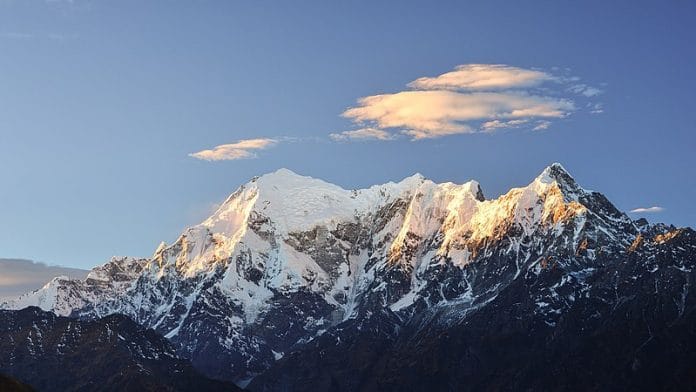Bengaluru: A new study has found that the Himalayas generate large quantities of natural aerosols that may play an important role in cloud formation and the Earth’s climate.
The Himalayas act as a giant barrier to wind flow, facilitating the accumulation of aerosols that are then transported to high altitudes by mountain winds. Aerosols are airborne particles that are formed from both natural sources, such as gases released by plants, and pollutants emitted by human activities.
The study has shown that a large quantity of natural aerosols are transported by winds and pumped into the upper troposphere in the Himalayas. Knowing this is also likely to help scientists understand the quantity and effect of human-made aerosols in the future.
The study was aimed at understanding the formation of clouds and aerosols, as well as the levels of natural aerosol in the Himalayas. The observations were taken at the remote Nepal Climate Observatory Pyramid station, situated 5,079 m above the sea level and a few kilometres below the Everest’s summit.
The findings were published this month in Nature Geoscience journal.
Also read: Celestial fireworks tonight as Geminids meteor shower set to peak
‘An aerosol factory’
Aerosols are microscopic solid, liquid, or mixed particles that remain suspended in the air. These form condensation nuclei — particles on which water vapour condenses — when they rise up the atmosphere, thus forming clouds.
However, since water content in the atmosphere doesn’t change in relation to aerosol change, an increased quantity of aerosols hold on to smaller droplets that fall to the ground slowly. Understanding clouds and cloud formation also helps scientists in predicting climate changes.
The key process when studying aerosols and their cloud-forming properties is new particle formation (NPF), the process that is behind aerosol numbers in the atmosphere.
NPF is a two-step process. First, aerosols about the size of 1 nanometer are formed from liquids or gases (called ‘precursors’), and then they grow to larger sizes by condensation as they rise through the cool atmosphere. NPF events are typically observed at high altitude or mountain atmospheric observatories regularly.
At the Nepal Climate Observatory Pyramid, NPF was observed almost on a daily basis.
The international research team conducted observations from 28 November to 25 December 2014, after the monsoon, when there was no wind blowing from the Indo-Gangetic plains towards the Himalayas. The researchers noticed that there was a high frequency of NPF events, where particles wider than 1 nanometer and ions wider than 0.8 nanometer formed clusters quickly, and rapidly grew to sizes larger than 10 nanometers.
The researchers were able to tell, via wind direction, that the majority of nanoparticles came from southwesterly winds. An analysis of these particles and ions also indicated that a large fraction of the particles were organic, originating from plants.
Plants emit a variety of volatile organic compounds from leaves, flowers, and roots. These are released as a response to stress, during reproduction or pollination, or as defence against insects.
Owing to the nature of the winds, these organic aerosols are transported over large distances and to higher altitudes of the Himalayas. The researchers concluded that the Himalayas act as an “free tropospheric aerosol factory”, and discovered that natural aerosols could be the source of nearly half of the atmosphere’s cloud condensation nuclei in the region, and thus influence cloud properties.
Significance and implication
When the Sun’s radiation and heat penetrates the Earth’s atmosphere, about a half of it reaches the surface. About a third gets scattered back to space, while the rest is absorbed within the atmosphere.
The land gets heated and this heat is then radiated back into space via the atmosphere. This heat is absorbed by greenhouses gases as well, further heating up the atmosphere.
The Earth remains in a radiation balance. It is exposed to tremendous amounts of heat and radiation from the Sun, which is balanced by the amount of heat and radiation escaping Earth. And this balance is important to maintain the planet’s climate.
When this natural balance gets affected, the phenomenon is known as radiative forcing. Understanding aerosol concentrations is important for monitoring radiative forcing.
When incoming radiation or trapped heat increases, there is positive forcing, and when the heat emitted into space increases, there is negative forcing.
Radiative forcing can be affected by many factors other than aerosols, and the global average of radiation absorption is about 240 watts per square metre.
It has been well established that when an imbalance in the radiation forces occur in the upper atmosphere, it is directly reflected as a change in surface temperature. Therefore, monitoring radiative forcing gives an approximate idea of the effects that could be seen on the surface.
Radiative forcing can be measured into the past, by looking at past aerosol records, and the effects of temperature on the surface. It is also useful for identifying new gases that humans may emit in future and the impact these would have on surface temperature, including assessing NPF.
The new study helps in understanding the effects of radiative forcing from the Himalayas and the extent of anthropogenic or human contribution to aerosols in the upper atmosphere.
Also read: Yale study finds why large mammals like elephants, tigers still exist in India







Sage Atri in Himalayan region climate
So, does this and a report regarding the moon controlling release of methane in antarctic prove Trump correct and absolves humans of global warming?????